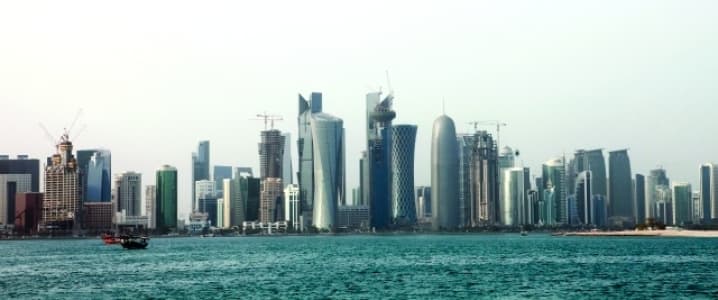The on-going diplomatic feud in the Persian Gulf pitting Qatar against a coalition of Arab states led by Saudi Arabia has already disrupted regional affairs to a significant extent: economic blockades, rejected airspace and closed embassies are just a few features of this sudden, somewhat unexpected rift between Doha and the rest of the Gulf.
Triggered by a hack of Qatar’s state website (a cybercrime which investigations have confirmed originated in the United Arab Emirates) that portrayed the country’s ruler as supporting the Islamic Republic of Iran, the feud is largely fueled by anger in Riyadh and other Arab capitals over Qatar’s independent foreign policy, particularly its alleged backing of terrorist groups and its relationship with Tehran.
An economic blockade on Qatar has not had a serious impact on the country’s ability to export natural gas, though there remains some risk it could force Doha to stray from OPEC’s production agreement.
In the wake of the crisis, there has been some speculation that Qatar, a U.S. ally, will draw closer to Iran’s orbit as a result of its feud with Saudi Arabia and the rest of the Arab world.
Ostracized by the rest of the Gulf, which largely sees Iran as a threat to regional stability, Qatar has relations with Iran that center around energy. The two countries share a massive natural gas field in the Persian Gulf and have cooperated in the past on the field’s exploitation, albeit often indirectly. The two countries do not join to develop the field but instead keep it separated into two distinct national zones. A Qatari-Iranian committee meets once a year to review outstanding issues that arise over sharing the field. Related: The Qatar Blockade Is Threatening The OPEC Deal
As Bloomberg notes, the diplomacy governing the South Pars/North Field shared by Qatar and Iran has been half competitive, half cooperative. Both countries view the field as a source of tremendous wealth but are wary of letting the other side pump more and siphon gas off from the main field.
In 2005, Qatar chose to halt further development of South Pars, arguing it needed time to study the field: yet the move was probably dictated by market calculations, as supplies of liquefied natural gas (LNG, Qatar’s chief export) exceeded world demand. Qatar ended this moratorium in April 2017.
Iran, on the other hand, has pressed ahead with its development of South Pars, drawing on fresh investment from its deal with Total. Since 2014 Iran has made developing South Pars a priority, and in 2020 its production from the field will exceed that of Qatar, according to Bloomberg.
Years of international sanctions and decaying infrastructure has kept Iranian LNG exports down, something which the Iranian government is eager to change, especially since Qatar has used its natural gas resources to transform itself into one of the world’s richest economies, a top LNG-exporter and regional powerhouse.
Despite the chance the two countries may come closer together in the wake of the Gulf feud, there remains a great deal separating them. Qatar remains a key U.S. ally (though President Donald Trump has indicated he favors Saudi Arabia) and home to a major U.S. military base. Iran backs the Syrian President Bashar Al-Assad, and Qatar has funded groups in the Syrian civil war which have bitterly opposed Assad’s ongoing rule.
On the energy front, Qatar and Iran compete for share of a global LNG market which has becoming increasingly crowded by new producers, including the United States. Qatar’s decision to end the moratorium on further development of the North Field is largely due to its concerns that increasing investment in LNG globally will reduce its competitiveness.
Despite holding the status of number one LNG exporter for more than a decade, Qatar’s market share has slowly been declining and now stands at nearly thirty percent of global LNG demand.
Related: Will Oil Inventories Continue To Fall Over The Summer?
Since lifting the moratorium Qatar has increased gas production from South Pars (or North Field, as it’s called in Doha). It announced a new development that will increase gas production by thirty percent, from 77 million tons to 100 million tons per year. Qatar possesses the third-largest gas reserves in the world, behind Russia and Iran.
ADVERTISEMENT
The plans to increase production would net yearly revenues of around $30 billion to Qatar, and international oil companies like ExxonMobil, Shell and Total are lining up for opportunities to join the new gas rush in the Gulf.
There’s little chance that Qatar, with a population of 2.5 million and an upcoming commitment to hose the World Cup in 2020, will choose to back away from the North Field. Its plans to increase production and retain its position as the world’s preeminent LNG exporter could upset Iran’s ambitions in that regard. Sharing the North Field/South Pars could become more acrimonious as the stakes become more serious. Then again, if the Gulf feud becomes worse and pressure on Doha builds, Qatar may find itself looking to Iran for support.
By Gregory Brew for Oilprice.com
More Top Reads From Oilprice.com:
- New Solar Tech Produces 50% More Energy Than Silicon Cells
- The Abrupt Demise Of Dutch Gas
- Why Oil Prices Can’t Gain Traction

















